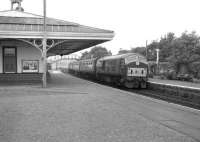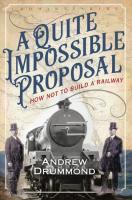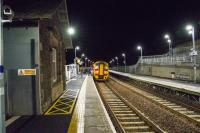News - David spaven
| Contact the news and picture editor. |
|
Themes ScotRail Edinburgh Trams Network Rail West Coast Main Line RMT Avanti West Coast Ferguson Marine Kyle Line Motherwell Windmillhill Flemington Ravenscraig Lockerbie Great British Railways Carstairs Golf MV Glen Sannox Newhaven Extension Dingwall Corran Ferry Edinburgh Trams Inquiry Derby Caledonian MacBrayne Railfreight Fife
|
On Monday, hundreds of towns and villages across Scotland may rue the day 60 years ago when Dr Richard Beeching unveiled his infamous report, The Reshaping of British Railways. With rail passengers haemorrhaging to private cars, the chairman of British Railways wrote a prescription which has ever since been associated with swingeing cuts in the network. The axe fell hard in Scotland, with some 850 miles of passenger railway closed between 1964 and 1972, the worst cut being delivered in 1969 when the entire 98-mile Waverley Route through the Borders was shut.
(Permalink) British Railways David Spaven Richard Beeching Waverley Route 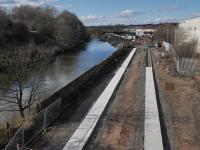 Levenmouth: Looking up river from the Bawbee Bridge with the new Levenmouth platforms under construction. 10 March
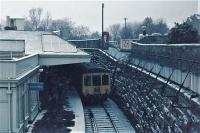 St Andrews [2nd]: A Gloucester DMU after arrival at St Andrews in wintry conditions on 28th December 1968. The station closed a week later. |
|
As cars turned the world of transport on its head, multiple Scottish railway branch lines were swept away by the Beeching Axe.
With that in mind, Spaven - an award-winning author with a life-long interest in the rail industry - meanders along the country's old branch lines, examining both their glory days and the devastating consequences of their closure. (Permalink) David Spaven Scotland's Lost Branch Lines - Where Beeching got it wrong |
|
A new book about the axing of a number of Scottish train lines in the 60s has been written by railway expert David Spaven.
(Permalink) David Spaven Scotland’s Lost Branch Lines |
|
David Spaven admits that he had picked up the trainspotting bug before he even left primary school. As a child of the 1950s and early 1960s and somebody in a household without a car, railway trips across Scotland became a cherished part of his family existence as he travelled the length and breadth of the country.
(Permalink) Beeching cuts Birlinn David Spaven Scotland's Lost Branch Lines 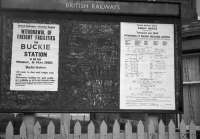 Buckie [GNSR]: Closure notice at Buckie, photographed on 2nd May 1968 - signalling the end was nigh in just a few days for both passenger and freight trains on the Moray Coast line - and advising that alternative se ... 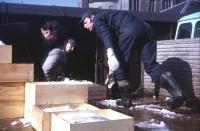 Fraserburgh: Loading fish for the London market at Fraserburgh on 27th March 1973. This and other insulated vans would leave on the (late morning) daily goods to Aberdeen where it would form part of the consist of ... 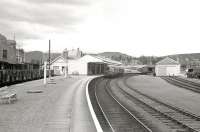 Ballater: General view of Ballater station on the Royal Deeside line in July 1962. The line closed in 1966 and the refurbished station building has since become a visitor centre and museum. The next train for A ... |
|
David Spaven has written a book review of Andrew Drummond's much anticipated new book, A Quite Impossible Proposal: How not to Build a Railway.
(Permalink) A Quite Impossible Proposal: How not to Build a Railway Andrew Drummond Aultbea David Spaven Dingwall and Skye Railway Stornoway Ullapool |
|
The new National Transport Strategy (NTS) for Scotland published earlier this month was greeted as a disappointment and a wasted opportunity by organisations with particular concerns about the all-encompassing climate emergency.
(Permalink) Climate change David Spaven National Transport Strategy |
|
Given the importance of timber to the rural Scottish economy with 10 million tonnes forecast to be harvested every year for the foreseeable future readers will perhaps be surprised to learn that not a single wagon of timber has moved by rail in Scotland for 10 years.
(Permalink) David Spaven Timber |
|
Since First Minister Nicola Sturgeon declared a 'climate emergency' in April, the political agenda has been moving inexorably - albeit too slowly - towards a radical transformation of Scottish transport investment priorities. Last month, a collaboration of seven sustainable transport campaigns came together to make the case for a fundamental reprioritisation, 'starting with an end to creating new trunk road capacity'.
(Permalink) Climate change David Spaven Nicola Sturgeon |
|
Policy change is needed to encourage investment, explains David Spaven
(Permalink) David Spaven Policy change |
|
The recent Scottish Government go-ahead for detailed design work on a reinstated passenger train service to Levenmouth was welcome news for a neglected corner of Scotland.
(Permalink) David Spaven Levenmouth |
|
The recent news that the Welsh Government has decided not to build the controversial M4 'relief' road near Newport should encourage Scottish Ministers to change direction on transport policy. The scrapping of the £2,000 million, 14-mile motorway plan for cost and environmental reasons has been hailed by Friends of the Earth Cymru as great news for Wales and the planet.
(Permalink) David Spaven Friends of the Earth Cymru M4 |
|
Ten years ago the rail freight industry had good cause to feel confident about the prospects for shifting freight from trucks to trains along the Perth-Inverness corridor.
In 2008, the Scottish Government's Strategic Transport Projects Review (STPR) identified upgrading the largely single-track Highland Main Line (HML) as the third-top priority among 29 road and rail schemes across Scotland. Investment of between £200 million and £450m was envisaged, including 'additional loops, dynamic loops or lengthening of double track sections' designed to benefit both passenger and freight traffic. (Permalink) David Spaven Highland Main Line Strategic Transport Projects Review |
|
Until the 1980s, a regular feature of Highland railway operation - on the Kyle and Mallaig lines in particular - was mixed trains, where the locomotive hauled both passenger coaches and freight wagons in a single trainload.
This was a useful way of sharing haulage costs on lightly-trafficked lines, but the practice disappeared when loco-hauled passenger trains were displaced by more economic diesel units with engines slung under their floors. (Permalink) David Spaven Kyle of Lochalsh Mallaig Mixed trains |
|
The Scottish Government's commitment to the development of rail freight - and the strategic benefits which it brings to the countrys economy and environment - is enshrined in the 'High Level Output Specification' (HLOS) for Control Period 6 (CP6) covering the years 2019 to 2024. Two statements stand out in this important document.
(Permalink) David Spaven High Level Output Specification |
|
The woes of one mode of transport can be a source of opportunity for another. The recent demise of the Rosyth-Zeebrugge freight ferry has boosted custom on the daily container train from Mossend (near Bellshill) to thriving Teesport “ and a second train is now planned to help Scottish exports on their way.
(Permalink) David Spaven Mossend Mossend Marshalling Yard |
|
Rail passengers doubtless welcomed the recent news that Transport Scotland had awarded a £10 million contract for upgrading crossing loops at Aviemore and Pitlochry as part of a wider £57m programme to enhance the largely single-track Highland Main Line (HML) from Perth to Inverness. But - compared with the steady progress of the £3bn dualling of the parallel A9 road - is that rail funding enough to make trains fully competitive with the car, the coach and the lorry?
(Permalink) A9 Aviemore David Spaven Highland Main Line Inverness Perth |
|
Passengers on the Borders Railway are still suffering volatile punctuality and poor service, two years after its opening teething troubles should have been sorted, according to campaigners. The line between Edinburgh and Tweedbank also suffers from stops being missed and overcrowding, said rail consultant and author David Spaven.
(Permalink) Borders Railway David Spaven Service 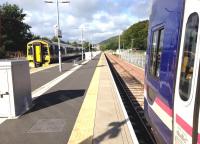 Tweedbank: A train from Edinburgh arriving at Tweedbank platform 1 on 29 September 2016 alongside a unit stabled in platform 2. 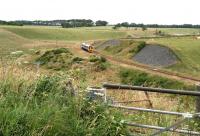 Falahill Summit: The late running 1253 Edinburgh - Tweedbank meets light rain as it rounds the curve at Falahill on 4 August 2016. |
|
Few of us need telling that whisky is central to Scotland's exporting economy. What is less well known is that the rail industry has been playing a crucial role in the transport of whisky to foreign markets for more than 50 years.
One of the key positive outcomes of the otherwise infamous Beeching Report of 1963 was the development of a network of container terminals linked by fast, fixed-formation 'Freightliner' trains. Terminals in Glasgow, and later Coatbridge, became central to the whisky supply chain and in 2017 Coatbridge Freightliner still provides those crucial daily links to Britain's big four Deep Sea ports at Felixstowe, Southampton, London Gateway and Liverpool. Indeed, between 20 and 25 per cent of Scottish exports are carried on these trains. (Permalink) David Spaven Freightliner Whisky  Elgin East: A typical scene at Elgin freight depot in the late 1970s - a BR lorry waits to offload a container of whisky casks for Central Scotland while a Class 24 draws a rake of conventional and container wago ... 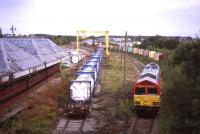 Elgin East: 66097 runs round its train of empty whisky tanks and containers at Elgin Yard on 13th September. The platform side of the former GNoSR passenger station has seen better days, but the main building is ... |
|
David Spaven's book, 'Highland Survivor' has won the Railway and Canal Historical Society award for '2017 Railway Book of the Year'. David commented 'Im delighted that this award will bring additional focus to a much-neglected railway, which deserves the same kind of attention as the better-known classic Highland tourist lines to Kyle, Fort William, Mallaig and Oban. ScotRail and tourist bodies should be applying to the Far North Line the same kind of transformative marketing as the highly successful North Coast 500 road campaign. The railway penetrates territory where no road goes, and over its half a dozen distinct geographical sections it skirts estuaries, climbs between mountain ranges and runs along a dramatic, unspoilt coastline. This is a hidden gem waiting to be discovered.'
(Permalink) David Spaven Far North Line Highland Survivor Kessock Books 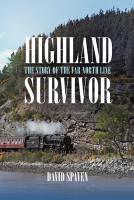 Book: We at Kessock Books are excited to announce the pending publication of 'Highland Survivor - The Story of the Far North Line' written by David ... |
|
The new Borders railway service is beset by cancellations, delays and unreliable trains, a new report has claimed.
Rail campaigners Bill Jamieson and David Spaven compiled the report from Network Rail and timetable data from the Realtime Trains website. They said it showed 'serious underperformance of the line', which re-opened in September 2015. Scotrail said it was 'determined' to find a solution to the 'challenges'. The Borders Rail Monitor report said that the line, which is run by Scotrail operator Abellio, was blighted by delays caused in part by poor infrastructure choices imposed by Transport Scotland. (Permalink) Abellio Bill Jamieson Borders Railway David Spaven ScotRail |
|
The 'shambolic' performance of Scotland's most northerly railway could lead to its eventual closure, a book published today claims. Passenger numbers are falling on the route between Inverness, Wick and Thurso, which has been plagued by chronic unreliability and frequent cancellations. In Highland Survivor: the story of the Far North Line, rail consultant David Spaven argues for urgent action to reverse its fortunes. The 168-mile route was the biggest reprieve among those earmarked for closure by the Beeching report 50 years ago. However, unlike most Scottish lines which have enjoyed booming traffic, Britain's longest rural route is declining and many journeys are far quicker by road.
(Permalink) David Spaven Far North Line Highland Survivor 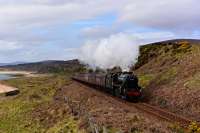 Loth: North of Brora, The Far North Line runs along the east coast until it reaches Helmsdale then turns inland to follow the Strath of Kildonan. Black 5 No. 44871 is pictured near Loth, between Brora and H ... 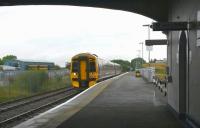 Thurso: About to board the 1307 service to Inverness at Thurso on 1 September 2015. 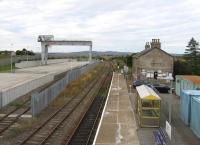 Georgemas Junction: No rural idyll these days. Georgemas Junction now features a mighty 110-tonne gantry crane for road-rail transfer of contaminated materials from the decommissioned Dounreay nuclear site. As seen here ... |
|
The Far North Line is one of the great rail survivors, but action is needed to ensure it stays on the transport map, says David Spaven Britain's longest rural railway - the 168-mile Far North Line from Inverness to Wick and Thurso - is one of the country's most remarkable rail survivors.
(Permalink) David Spaven Far North Line |
|
This day last year marked one of the most remarkable achievements in British railway history. The opening of the line to Tweedbank ended the Scottish Borders' unwanted 46-year status as the only region of Britain without a train service “ with the 30 miles of new Borders Railway constituting the longest line ever re-opened in the country.
(Permalink) Borders Railway David Spaven |
|
New study offers chance to plan for the next 25 years, writes David Spaven
As the representative body for users and suppliers of rail freight throughout Britain, the Rail Freight Group (RFG) was pleased to have the opportunity to comment on Network Rails (NR) recent draft Scotland Route Study, setting out the options for upgrading the network over the next 25 and more years. The capacity and capability of the network will be key determinants of rail freights success in contributing to important policy objectives, such as: supporting economic growth and resilience, and greater choice for industry; meeting Scotlands challenging climate change targets; and reducing the heavy trunk road maintenance burden imposed by the biggest lorries. (Permalink) David Spaven Network Rail Rail Freight Group |
|
The author of a book about the Borders to Edinburgh railway has said tourist and leisure passengers could be 'a crucial factor' in its success.
David Spaven said that was in contrast with the original 'downbeat verdict' on the route's potential for such traffic. He welcomed recent Scottish government backing for the important market and the 'scenic qualities' of the line. Mr Spaven also praised the Campaign for Borders Rail for pressing the case for the tourist potential of the route. The multi-million pound rail link between Tweedbank in the Borders and Edinburgh is scheduled to open to passengers in September. (Permalink) Borders Railway Campaign for Borders Rail David Spaven |
|
We need more joined-up thinking if we are to succeed in switching Scotland's freight traffic from road to rail, writes David Spaven.
Everyone wants to see more freight on rail - the potential benefits to the economy, environment, climate and road safety are substantial - but in practice how can we achieve a significant modal shift from road haulage? The terms of competition between road, rail and sea have to be fair, of course - not least in terms of providing rail-route infrastructure which is fit for modern purpose, allowing cost-effective, long trains to convey the modern generation of tall containers across the trunk rail network. However, good routes are not enough, as rail - like sea transport, but unlike road haulage - also needs a comprehensive network of terminals to provide access to the system. (Permalink) David Spaven |
|
A critical aspect of road/rail freight competition is the ease with which trucks can go anywhere - and this is a particular issue in the transport of international containers. Over the past 40 years, the key trend has been for containers to become progressively higher - initially to 8'6' and now 9'6'. While this causes no problem across our modern road system, where bridges and tunnels have been built with generous 'loading gauge', the situation is very different on the rail network.
***The above CILT event will take place at the Royal Over-Seas League, Over-Seas House, 100, Princes Street, Edinburgh, EH2 3AB on Tuesday 18 November, 17.30 for 1800. There is no charge for this event and no booking required. A light buffet will be provided. (Permalink) CILT David Spaven |
|
Wherever you travel on Scotland's road network, you see lorries. One of the great strengths of road haulage is that it can take advantage of more than 50 years of continuous improvement in the capacity and quality of the country's trunk roads. Moving goods by road has become simpler, faster and cheaper - and, despite Scotland's climate change targets, the Scottish Government has plans for a further £9 billion in road investment, which will make it ever harder for the more sustainable mode of transport, the freight train, to compete with the truck.
(Permalink) David Spaven |
|
Scotland's killer road has just got more deadly - while the safest form of transport wasn't even given a look-in, argues David Spaven. The crude politics of the Perth-Inverness transport corridor will just not go away. Despite the safety gloss being presented to the public, new evidence obtained from the Scottish Government by the Rail Freight Group (RFG) shows that the planned increase in lorry speed limits from 40mph to 50mph on single-carriageway sections of the A9 is being driven by 'operational benefits' - and more lives will be lost as the price of government helping to keep truckers competitive.
(Permalink) A9 David Spaven Highland Main Line Rail Freight Group |
|
Rail freight and road hauliers are competing on a playing field that is far from level, says David Spaven.
(Permalink) A9 David Spaven Highland Main Line |
|
Calls to raise HGV speed limits on the A9 could damage plans to boost train services, says David Spaven.
I was delighted to witness the launch of the Lifting the Spirit trial whisky train service from Elgin to Grangemouth last month - a tangible example of how rail could be attracting freight away from Scotland's trunk roads. In the longer term, the new train service has the potential to secure a significant freight modal switch away from the A95 and A9 roads on to rail services to Central Scotland. But, worryingly, moves to increase lorry speed limits on the A9 could undermine this innovative attempt to take advantage of safer and more sustainable rail freight. Lifting the Spirit is a collaboration between big distilling companies such as Diageo and Pernod Ricard, the rail industry, Highlands & Islands Enterprise, local authorities and the European Union Foodport project to improve the logistics of food and drink distribution and to cut carbon emissions. An added incentive is that the initiative might help to cut the toll of fatalities and injuries on the A9. (Permalink) A9 A95 David Spaven Elgin Grangemouth 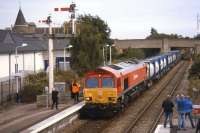 Elgin: DBS 66097 brings a train of empty whisky tanks and containers into Elgin Up Loop on 13th September 2013, prior to propelling back into Elgin Yard. The movement was in connection with the next day's i ...  Elgin East: 66097 runs round its train of empty whisky tanks and containers at Elgin Yard on 13th September. The platform side of the former GNoSR passenger station has seen better days, but the main building is ... |
|
Racing to build a safer road north forfeits the alternative option to improve our economy and the environment at the same time, says David Spaven.
In all the recent debates on reducing the toll of deaths and injuries on the A9 between Perth and Inverness, very little has been heard about the potential solutions offered by the country's safest mode of overland freight transport - the railway. (Permalink) A9 David Spaven Highland Main Line  Gleneagles: DRS 66430 coasts downhill to the south of Gleneagles on 12 April with the 4D47 Inverness - Mossend intermodal, composed entirely of Tesco containers.
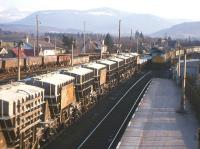 Aviemore: Two Class 26s pull into Aviemore in 1974 with a northbound passenger service, while sister locomotive no D5321 waits for the road to Kingussie with a Millerhill-bound freight dominated by empty Preslo ... 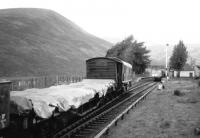 Dalnaspidal: Freights about to cross at Dalnaspidal in the summer of 1970 - looking north. |
|
Once Dr Richard Beeching had unveiled his infamous report on The Reshaping of British Railways, 50 years ago today, the country's rail network would never again be the same. But - with hindsight - does he really deserve his reputation as an axeman or was he simply doing a job which had to be done?
(Permalink) Borders Rail David Spaven Dr Richard Beeching The Reshaping of British Railways Waverley Route |
|
It is 50 years since Dr Richard Beeching's report on British Railways which led to hundreds of stations and 650 miles of railway line being closed in Scotland. The axing of the 98-mile Waverley Route from Edinburgh to Carlisle was the worst of all the Beeching cuts, according to author and railway expert David Spaven. The closure left the Scottish Borders as the only region of Britain without a train service and Hawick, 56 miles from Edinburgh and 42 miles from Carlisle, as the largest town farthest from a railway station.
(Permalink) Borders Rail David Spaven Dr Richard Beeching The Reshaping of British Railways Waverley Route  Kershopefoot: Too fast for an Ilford Sportsman! With window glass starting to rattle and surface ripples suddenly appearing on the signalman's mug of tea, the peace and tranquility at Kershopefoot is rudely ... 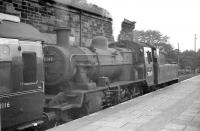 St Boswells: With less than two years to go before the last scheduled passenger train over the through route, a departure for Berwick via Kelso waits in the bay at the south end of St Boswells station on 10 Septem ... 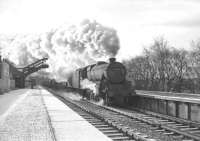 Riddings Junction: 'Twas a cold and frosty morning.... A chilly-looking scene on the platform at Riddings Junction in November 1964 as one of Kingmoor's Black 5s, no 45481, thunders north through the station wi ... |
|
Those who have been following the various Railscot updates on David Spaven's book Waverley Route - the life, death and rebirth of the Borders Railway, will be pleased to hear the book is officially due for publication on 29 August 2012. The cover is shown opposite and a press release from Argyll Publishing can be accessed by clicking on the link below.
(Permalink) death and rebirth of the Borders Railway Borders Railway David Spaven New Book Waverley Route - the life |
|
A rail consultant has told of his surprise at finding a Victorian engineer's proposals for a rail link between Scotland and Ireland.
Edinburgh-based David Spaven believed the plans for a tunnel, causeway or an undersea bridge between Stranraer and Belfast were not widely known today. The plans feature in a new book, Mapping the Railways, Mr Spaven has co-written with author Julian Holland. It also includes abandoned ideas for light railways on Skye and Lewis. Published for the The Times by Collins, the book has been described as the most comprehensive collection of British railway maps dating from 1819 to the present day. (Permalink) Belfast Book David Spaven Jullian Holland Lewis Mapping the Railways Skye Stranraer |
|
A memorial seat to Frank Spaven was unveiled at Inverness Station prior to a meeting of the Highland Rail Partnership. Frank Spaven was the first head of planning at the Highlands and Islands Development Board and was instrumental in the saving of the Far North and Kyle lines from Inverness.
(Permalink) David Spaven Frank Spaven Highland Rail Partnership Kyle Line |
